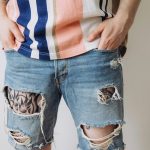Imagine your clothes as a shield against the sticky embrace of humidity, where every thread plays a role in your comfort. You might think any fabric will do, but choosing the right material can make all the difference between feeling clammy and staying fresh. What if the secret lies not just in the fabric itself, but in how it interacts with moisture and air? Understanding this could change how you dress for humid days.
Table of Contents
Key Takeaways
- Choose moisture-wicking fabrics that pull sweat away from skin for quick drying and cooling in humid climates.
- Opt for breathable materials like linen and cotton blends to enhance air circulation and prevent stickiness.
- Lightweight fabrics improve comfort by reducing heat retention and allowing better airflow.
- Synthetic fibers like polyester offer quick drying but may trap heat; balance with natural fibers for optimal comfort.
- Light-colored clothing reflects sunlight, reducing heat absorption and keeping you cooler in humid conditions.
Understanding Moisture-Wicking and Breathable Fabrics
Although you mightn’t always notice, the fabric you choose plays a crucial role in how comfortable you feel in humid climates.
Fabrics with excellent moisture management actively pull sweat away from your skin, helping you stay dry and cool. When you wear breathable fabric, air circulates freely, allowing moisture to evaporate quickly. This combination prevents that sticky, uncomfortable feeling you often get in high humidity.
Moisture-wicking and breathable fabrics keep you dry and comfortable by letting sweat evaporate quickly.
Understanding moisture-wicking and fabric breathability means recognizing how these properties work together to regulate your body temperature. When fabric breathability is high, it enhances moisture management, ensuring sweat doesn’t linger.
Choosing materials with these features supports your comfort by keeping you dry and reducing overheating, which is essential for staying comfortable during hot, humid days.
Top Fabric Choices for Managing Humidity
When you pick fabrics designed to handle humidity, you’ll notice a significant difference in comfort and dryness.
Cotton blends are a top choice because they combine the breathability of natural cotton with fibers that improve moisture management and durability. These blends wick sweat away, helping your skin stay dry even on the stickiest days.
Lightweight linens are another excellent option, offering superior airflow and quick-drying properties. Linen’s natural texture allows air to circulate freely, preventing that clammy feeling common in humid weather.
Both cotton blends and lightweight linens are ideal for keeping you cool without sacrificing comfort or style. Choosing these fabrics guarantees you stay fresh and comfortable, making them smart picks for managing humidity effectively.
How Fabric Technologies Enhance Comfort in Humid Weather
Since humid weather can make you feel sticky and uncomfortable, fabric technologies play an essential role in improving your daily wear.
Modern fabric innovations focus on enhancing breathability and moisture management, helping you stay cool and dry even when the air feels heavy.
Cooling technologies like moisture-wicking fibers quickly draw sweat away from your skin, speeding up evaporation and reducing clamminess.
Moisture-wicking fibers pull sweat from your skin, enhancing evaporation and keeping you dry and comfortable.
Some fabrics also use special finishes that reflect heat or increase airflow, allowing your body to regulate temperature more effectively.
By choosing garments with these advanced features, you’ll feel less weighed down by humidity and more comfortable throughout the day.
These fabric breakthroughs guarantee your clothing works with your body, not against it, keeping you fresh no matter how muggy it gets.
Natural vs. Synthetic: What Works Best in Humidity?
How do natural and synthetic fabrics compare when it comes to handling humidity?
If you’re choosing between cotton vs. linen, linen usually wins for humid days because it breathes better and dries faster, keeping you cooler.
Cotton feels soft but tends to hold moisture longer, which can leave you feeling damp.
On the synthetic side, polyester advantages include quick drying and moisture-wicking properties that pull sweat away from your skin.
However, polyester might trap heat more than natural fibers, so it’s best for activewear designed to handle sweat efficiently.
Ultimately, you’ll want to balance comfort and moisture management—natural fabrics like linen excel at breathability, while synthetics like polyester offer superior drying and moisture control in humid climates.
Tips for Selecting the Ideal Fabric for Your Climate and Activity
Choosing the right fabric means considering both the climate and your daily activities. In humid conditions, opt for lightweight fabrics that allow your skin to breathe, helping you stay cool and dry.
Fabric weight plays a significant role—lighter materials like linen or thin cotton are ideal for outdoor activities, while slightly heavier fabrics might suit indoor settings with air conditioning. Your color choice also matters; lighter colors reflect sunlight and heat, keeping you cooler, whereas dark colors absorb heat and can make you feel warmer.
Additionally, consider how much you’ll be moving—if you’re active, choose fabrics with moisture-wicking properties. By balancing fabric weight and color choice with your environment and routine, you’ll stay comfortable no matter the humidity.
Frequently Asked Questions
How Do Fabric Blends Affect Moisture-Wicking Efficiency?
You’ll find fabric composition essential because it influences blend performance by balancing moisture absorption and evaporation. When you choose the right blend, it enhances moisture-wicking efficiency, keeping you cooler and drier during humid conditions.
Can Moisture-Wicking Fabrics Cause Skin Irritation Over Time?
Oh, sure, your skin just *loves* irritation from moisture-wicking fabrics! If you’ve got delicate skin sensitivity, those synthetic blends might betray you. Always check fabric composition to dodge itchy regrets—you deserve comfy, not cranky!
Are Moisture-Wicking Clothes Environmentally Sustainable?
You’ll find moisture-wicking clothes vary in eco friendliness; some use eco friendly materials and sustainable practices, while others rely on synthetic fibers that aren’t biodegradable, so choosing brands committed to sustainability matters a lot.
How Often Should Moisture-Wicking Garments Be Replaced?
Back in the days of dial-up, you’d still wonder about replacement frequency. You should replace moisture-wicking garments once their garment lifespan ends, usually after 12-18 months, depending on wear and washing habits.
Do Moisture-Wicking Fabrics Lose Effectiveness After Washing?
Yes, moisture-wicking fabrics can lose effectiveness after washing. Durability testing shows improper washing techniques, like using harsh detergents or high heat, degrade their performance. You should follow care instructions to maintain their moisture management.
- Does Chiffon Fabric Stink - July 15, 2025
- Does Chiffon Fabric Affect the Economy - July 15, 2025
- Does Cotton Fabric Have a Nap - July 15, 2025







